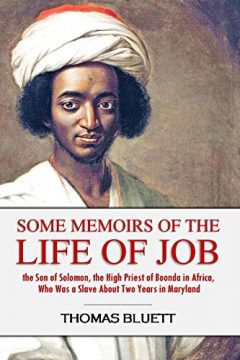 |
 |
Location: Enslaved in Annapolis, Maryland / Kent County, Maryland
Location: Portrait National Portrait Gallery in London, England
Ayuba Suleiman Diallo (1701-1773) was enslaved on a tobacco plantation near Annapolis Maryland. His portrait of was painted by William Hoare of Bath in 1733 and hangs in the National Portrait Gallery in London, England.
“Ayuba Suleiman Diallo (1701-1773), known as Job Ben Soloman to American and European acquaintances, was born a son of [a cleric] of the Futa peoples in the West African state of Bundu at the mouth of the Gambia River. Diallo was a literate, young, Muslim merchant in 1731, when he and his interpreter were captured and sold into the Atlantic slave trade while traveling along the Gambia. Shipped to Annapolis, Maryland, Diallo spent two years there as a slave on a tobacco plantation. Following an attempted escape, Diallo was imprisoned in a Kent County courthouse some distance away from his plantation. There, Diallo was discovered by Thomas Bluett: an attorney, judge, and clergyman of the county. After Bluett returned him to his plantation, Diallo wrote a letter intended for his father, but instead it reached James Oglethorpe, the Director of the Royal African Company. Moved by this letter, Oglethorpe purchased Diallo’s freedom and paid for Diallo to travel across the Atlantic to stay with him in London.,,,” (Thomas Bluett)
“Ayuba Suleiman Diallo (named Job ben Solomon in England) was an educated Muslim nobleman from west Africa who was captured in 1730, enslaved for two years in Maryland, then freed through the efforts of attorney Thomas Bluett, who compiled and published Job’s memoir in 1734. Bluett helped Job ben Solomon return to his homeland in Africa (via England) “where we hope he is safely arrived to the great joy of his friends, and the honour of the English nation” (National Humanities Center)
“Ayuba Suleiman Diallo was an educated man from a family of Muslim clerics in West Africa. In 1731 he was taken into slavery and sent to work on a plantation in America. By his own enterprise, and assisted by a series of spectacular strokes of fortune, Diallo arrived in London in 1733. Recognised as a deeply pious and educated man, in England Diallo mixed with high and intellectual society, was introduced at Court and was bought out of slavery by public subscription. Through the publication of his Memoirs in 1734, Diallo had an important and lasting impact on Britain’s understanding of West African culture, black identity and Islam. In the early years of the nineteenth-century, advocates of the abolition of slavery would cite Diallo as a key figure in asserting the moral rights and humanity of black people.” (National Portrait Gallery)
Resources
Austin, Allan. African Muslims in Antebellum America. New York Garland Pub., 1984.
Bluett, Thomas. Some Memoirs of the Life of Job, the Son of Solomon, the High Priest of Boonda in Africa… National Humanities Center Resource Toolbox, Primary Resources in U.S. History and Literaturehttp://nationalhumanitiescenter.org/
Bluett, Thomas. Some Memoirs of the Life of Job, the Son of Solomon, the High Priest of Boonda in Africa, Etc. London: Richard Ford, 1734. Print.
Diouf, Sylviane, Servants of Allah : African Muslims Enslaved in the Americas. New York: University Press, 1998.
Fraser-Rahim, Muhammad. “Enslaved and Freed African Muslims: Spiritual Wayfarers in the South and Low Country.” Lowcountry Digital History Initiative, College of Charleston. Accessed 5/9/2019.
Grant, Douglas. A Fortunate Slave. New York: Oxford University Press. 1969.
Moore, Francis, Active 1744, et al. Travels into the inland parts of Africa. London, Printed by E. Cave for the author, 1738. Pdf. Retrieved from the Library of Congress, <www.loc.gov/item/05014443/>.
Nyang, Sulayman, Islam in the United States. ABC International Group, 1999.
“Thomas Bluett.” Documenting the American South: Primary Resources for the Study of Southern History, Literature and Culture) University Library, The University of North Carolina at Chapel Hill, 2004. Accessed 11/23/2016. Online version: http://nationalhumanitiescenter.org
“Two African Gentlemen in London.” Victoria and Albert Museum. http://www.vam.ac.uk/.Accessed 11/23/2016.
